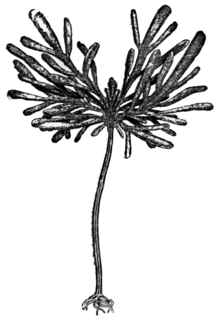Arame
| Eisenia bicyclis | |
|---|---|
 | |
| Scientific classification | |
| (unranked): | SAR |
| Superphylum: | Heterokonta |
| Class: | Phaeophyceae |
| Order: | Laminariales |
| Family: | Lessoniaceae |
| Genus: | Eisenia |
| Species: | E. bicyclis |
| Binomial name | |
| Eisenia bicyclis (Kjellman) Setchell 1905 | |
| Synonyms | |
|
Ecklonia bicyclis | |
Arame (荒布, Eisenia bicyclis, syn. Ecklonia bicyclis), sea oak is a species of kelp best known for its use in Japanese cuisine.
Description
Eisenia bicyclis is limited in distribution to temperate Pacific ocean waters, mostly around Japan, although it is deliberately cultured elsewhere, including South Korea.[1] It grows and reproduces seasonally. Two flattened oval fronds rise from a stiff woody stipe which can be up to about 1 metre (3.3 ft) tall. The fronds are shed and new ones formed annually. The plant appears both branched and feathered. It may be harvested by divers manually or mechanically, and the dried form is available year round.[1]
Cuisine
It is one of many species of seaweed used in Asian cuisine.
Usually purchased in a dried state, it is reconstituted quickly, taking about five minutes. Arame comes in dark brown strands, has a mild, semi-sweet flavor, and a firm texture.[1] It is added to appetizers, casseroles, muffins, pilafs, soups, toasted dishes, and many other types of food. Its mild flavor makes it adaptable to many uses.[2]
Chemistry
Arame is high in calcium, iodine, iron, magnesium, and vitamin A as well as being a dietary source of many other minerals.[1] It also is harvested for alginate, fertilizer and iodide.[3] It contains the storage polysaccharide laminarin and the tripeptide eisenin, a peptide with immunological activity.
Lignan content in arame is noted by several sources. It also contains the phlorotannins phlorofucofuroeckol A, dioxinodehydroeckol, fucofuroeckol A,[4] eckol, dieckol, triphloroethol A and 7-phloroethol.[5] Extracts of this algae have been tested to combat MRSA staph infections.[6]
See also
References
- 1 2 3 4 Arame, Food to Good Health, 2010 retrieved 8 February 2013
- ↑ Arame Seaweed, Diet Foods & Nutrition, retrieved 8 February 2013
- ↑ Chapman, V.J. (1950). Seaweeds and Their Uses. Taylor & Francis. Retrieved 8 February 2013.
- ↑ Eom, Sung-Hwan; Lee, Sang-Hoon; Yoon, Na-Young; Jung, Won-Kyo; Jeon, You-Jin; Kim, Se-Kwon; Lee, Myung-Suk; Kim, Young-Mog (2012). "Α-Glucosidase- and α-amylase-inhibitory activities of phlorotannins from Eisenia bicyclis". Journal of the Science of Food and Agriculture. 92 (10): 2084–90. doi:10.1002/jsfa.5585. PMID 22271637.
- ↑ Jung, HA; Oh, SH; Choi, JS (2010). "Molecular docking studies of phlorotannins from Eisenia bicyclis with BACE1 inhibitory activity". Bioorganic & Medicinal Chemistry Letters. 20 (11): 3211–5. doi:10.1016/j.bmcl.2010.04.093. PMID 20462757.
- ↑ Eom, Sung-Hwan; Park, Jae-Hong; Yu, Dae-Ung; Choi, Ji-Il; Choi, Jong-Duck; Lee, Myung-Suk; Kim, Young-Mog (2011). "Antimicrobial Activity of Brown Alga Eisenia bicyclis against Methicillin-resistant Staphylococcus aureus" (PDF). Fish Aquat Sci. The Korean Society of Fisheries and Aquatic Science. 14 (4): 251–256. doi:10.5657/FAS.2011.0251. Retrieved 8 February 2013.
| Wikimedia Commons has media related to Eisenia bicyclis. |
Additional reading
- Menshova, Roza; Ermakovaa, Svetlana; Anastyuka, Stanislav; Isakova, Vladimir; Dubrovskayaa, Yuliya; Kusaykina, Mikhail; Umb, Byung-Hun; Zvyagintseva, Tatiana (2013). "Structure, enzymatic transformation and anticancer activity of branched high molecular weight laminaran from brown alga Eisenia bicyclis". ScienceDirect: 101–109.
- Kojima, T.; et al. (1993). "Eisenin (L-pyroGlu-L-Gln-L-Ala), a new biological response modifier". Journal of Immunotherapy. 13 (1): 36–42.
- Kristina Turner. 1996. The Self-Healing Cookbook: A Macrobiotic Primer for the Healing Body. p. 122
- Herry Cahyana, Antonius; Shuto, Yoshihiro; Kinoshita, Yoshiro (26 December 1991). "Pyropheophytin a as an antioxidative substance from the marine alga, arame (Eisenia bicyclis)". Bioscience, Biotechnology and Biochemistry. 56 (10): 1533–1535. doi:10.1271/bbb.56.1533.
Further reading
Iwata, Kayoko. Tagami, Keiko. Uchida, Shigeo. (July 16, 2013). “Ecological Half-Lives of Radiocesium in 16 Species in Marine Biota after the TEPCO's Fukushima Daiichi Nuclear Power Plant Accident.” Environmental Science and Technology. Vol. 47. Issue. 14. Web of Science Core Collection.
Paudel, U; Lee, Y-H; Kwon, T-H; Park, N-H; Yun, B-S; Hwang, P-H; Yi, H-K (August 2014). "Eckols reduce dental pulp inflammation through the ERK1/2 pathway independent of COX-2 inhibition". Oral Diseases: n/a–n/a. doi:10.1111/odi.12266.
External links
- AlgaeBase Profile, M.D. Guiry in Guiry, M.D. & Guiry, G.M. 2013. AlgaeBase. National University of Ireland, Galway, retrieved 8 February 2013.